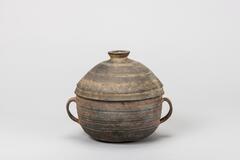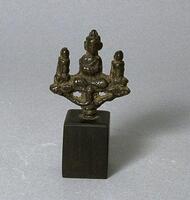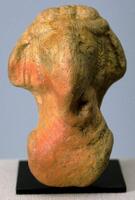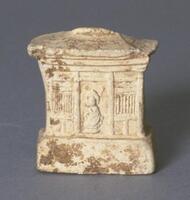39 UMMA Objects
39 UMMA Objects

Korean (Korean (culture or style))
Storage Jar on cut-out pedestal foot
500 – 699
Gift of Bruce and Inta Hasenkamp and Museum purchase made possible by Elder and Mrs. Sang-Yong Nam
2004/1.174
![The gray jar with a little long neck has a foot with rectangular perforations and is potted with fine silt-based clay. The relatively thin mouth is slightly everted. Three deep incisions encircle the midsection of the neck. The globular body is decorated with two incised line encircled the body. The foot whose bottom is rolled outward is a little high and wide.<br />
<br />
The long and splayed neck of this blue-gray, high-fired stoneware jar is encircled by two sets of ridges. The set on the upper section of the neck has two ridges, and the set on the lower section has one ridge. The rim is narrow and round. The inner surface of the neck shows rough, uneven surfaces resulting from wheel throwing. The body is widest at its middle. The vessel surface has been smoothed by paring on a wheel after attaching the low pedestal. The pedestal shows six rectangular perforations.
<p>[Korean Collection, University of Michigan Museum of Art (2017) p. 51]</p>
The gray jar with a little long neck has a foot with rectangular perforations and is potted with fine silt-based clay. The relatively thin mouth is slightly everted. Three deep incisions encircle the midsection of the neck. The globular body is decorated with two incised line encircled the body. The foot whose bottom is rolled outward is a little high and wide.<br />
<br />
The long and splayed neck of this blue-gray, high-fired stoneware jar is encircled by two sets of ridges. The set on the upper section of the neck has two ridges, and the set on the lower section has one ridge. The rim is narrow and round. The inner surface of the neck shows rough, uneven surfaces resulting from wheel throwing. The body is widest at its middle. The vessel surface has been smoothed by paring on a wheel after attaching the low pedestal. The pedestal shows six rectangular perforations.
<p>[Korean Collection, University of Michigan Museum of Art (2017) p. 51]</p>](/media/W1siZiIsIjIwMjIvMDkvMjQvMWNyMzV3bGVrZ19kZWZhdWx0LmpwZyJdLFsicCIsInRodW1iIiwiMjQweDIwMCJdXQ?sha=7b00061238459019)
Korean (Korean (culture or style))
Storage Jar on cut-out pedestal foot
400 – 599
Gift of Bruce and Inta Hasenkamp and Museum purchase made possible by Elder and Mrs. Sang-Yong Nam
2004/1.176

Korean (Korean (culture or style))
Two-handled bowl with cover
400 – 599
Gift of Bruce and Inta Hasenkamp and Museum purchase made possible by Elder and Mrs. Sang-Yong Nam
2004/1.182A&B

Chinese (Chinese (culture or style))
Miniature altar fragment: Seated Buddha flanked by two attendants
6th century
Gift of F. Karel Wiest
1981/2.73
![A ceramic lid for a matching bowl. Outfitted with a small, round and tapered handle.<br />
<br />
This yellow, low-fired earthenware vessel consists of a body and a lid. It is made from fine clay mixed with a small amount of fine sand particles. Fine, incised horizontal lines run around the body. The gallery that supports the lid rests at a slight incline, and the vessel mouth slopes slightly inwards. The lower part of the body rapidly tapers inwards before joining the base, the center of which is indented. The lid features a low, flat knob. The round, upper part of the lid meets the lip at a slight angle.[Korean Collection, University of Michigan Museum of Art (2017) p. 45]<br />
A ceramic lid for a matching bowl. Outfitted with a small, round and tapered handle.<br />
<br />
This yellow, low-fired earthenware vessel consists of a body and a lid. It is made from fine clay mixed with a small amount of fine sand particles. Fine, incised horizontal lines run around the body. The gallery that supports the lid rests at a slight incline, and the vessel mouth slopes slightly inwards. The lower part of the body rapidly tapers inwards before joining the base, the center of which is indented. The lid features a low, flat knob. The round, upper part of the lid meets the lip at a slight angle.[Korean Collection, University of Michigan Museum of Art (2017) p. 45]<br />
](/media/W1siZiIsIjIwMjIvMDkvMjQvMm9nbHVzanppOF9kZWZhdWx0LmpwZyJdLFsicCIsInRodW1iIiwiMjQweDIwMCJdXQ?sha=88066081a177047d)
Korean (Korean (culture or style))
Lid for Bowl
400 – 599
Gift of Ok Ja Chang and the Chang Family
2009/2.75B

Japanese (Japanese (culture or style))
Sueki ware hasô
567 – 699
Museum Purchase made possible by the Margaret Watson Parker Art Collection Fund
2002/1.231
![Dark gray high-fired stoneware cup. The base is tinged dark green and a natural glaze has formed on the outer surface, and on some of the inner surface. Two horizontal ridges encircle the body, and the edge rim is sharp.<br />
<br />
This is a dark gray, high-fired stoneware cup. The base is tinged dark green. Natural glaze has formed on the entire outer surface and parts of the inner surface. The edge of the rim is sharp. Two horizontal ridges encircle the body. The base of the cup is flat and rounded where it joins the body. The wall is thicker at the base than at the rim or the central body.
<p>[Korean Collection, University of Michigan Museum of Art (2017) p. 72]</p>
Dark gray high-fired stoneware cup. The base is tinged dark green and a natural glaze has formed on the outer surface, and on some of the inner surface. Two horizontal ridges encircle the body, and the edge rim is sharp.<br />
<br />
This is a dark gray, high-fired stoneware cup. The base is tinged dark green. Natural glaze has formed on the entire outer surface and parts of the inner surface. The edge of the rim is sharp. Two horizontal ridges encircle the body. The base of the cup is flat and rounded where it joins the body. The wall is thicker at the base than at the rim or the central body.
<p>[Korean Collection, University of Michigan Museum of Art (2017) p. 72]</p>](/media/W1siZiIsIjIwMjIvMDkvMjQvNTMxa2k0bmppNl9kZWZhdWx0LmpwZyJdLFsicCIsInRodW1iIiwiMjQweDIwMCJdXQ?sha=a1fc04cb9cf817cf)
Korean (Korean (culture or style))
Cup
400 – 599
Gift and partial purchase from Bruce and Inta Hasenkamp, purchase with funds from Elder and Mrs Sang-Yong Nam
2021/1.142
![It has a flat base, globular body and straight neck with an everted rim. The color is dark grayish-blue.<br />
<br />
This is a blue-gray, high-fired stoneware cup with a handle. The mouth of the cup is slightly splayed and has a narrow, rounded rim. The body is widest at its center where a semicircular handle is attached vertically. The inner and outer surfaces show faint traces of rotation and water smoothing. The base is wide and flat and has no foot.
<p>[Korean Collection, University of Michigan Museum of Art (2017) p. 70]</p>
It has a flat base, globular body and straight neck with an everted rim. The color is dark grayish-blue.<br />
<br />
This is a blue-gray, high-fired stoneware cup with a handle. The mouth of the cup is slightly splayed and has a narrow, rounded rim. The body is widest at its center where a semicircular handle is attached vertically. The inner and outer surfaces show faint traces of rotation and water smoothing. The base is wide and flat and has no foot.
<p>[Korean Collection, University of Michigan Museum of Art (2017) p. 70]</p>](/media/W1siZiIsIjIwMjIvMDUvMjUvNGV2em85OThkdF9kZWZhdWx0LmpwZyJdLFsicCIsInRodW1iIiwiMjQweDIwMCJdXQ?sha=2d2a81114b915f5e)
Korean (Korean (culture or style))
Cup with small handle
400 – 599
Gift of Toshiko Ogita in memory of Tomoo Ogita
1987/1.310

Indian (Indian (South Asian))
From Northern India, figure of seated Ganesha on perforated cylinder (armature of wheeled toy deity).
300 – 599
Gift of Dr. and Mrs. Leo S. Figiel and Dr. and Mrs. Steven J. Figiel
1980/2.280

Indian (Indian (South Asian))
Ganesha,
300 – 599
Gift of Dr. and Mrs. Leo S. Figiel and Dr. and Mrs. Steven J. Figiel
1980/2.281
![It looks like a rescent, animal's tooth or fetus. There is a hole and some carved line on the head part.<br />
<br />
This is a comma-shaped bead made from dark green jade. Such crescent moon-shaped beads, referred to as<em> gogok</em>, were used to decorate golden crowns, clothing, and belts. This example, which was attached to other ornaments via the hole in its head, is typical of comma-shaped beads of the Three Kingdoms period. Three parallel lines are incised across the hole, from which four more incised lines radiate upwards.<br />
[Korean Collection, University of Michigan Museum of Art (2017) p.33] It looks like a rescent, animal's tooth or fetus. There is a hole and some carved line on the head part.<br />
<br />
This is a comma-shaped bead made from dark green jade. Such crescent moon-shaped beads, referred to as<em> gogok</em>, were used to decorate golden crowns, clothing, and belts. This example, which was attached to other ornaments via the hole in its head, is typical of comma-shaped beads of the Three Kingdoms period. Three parallel lines are incised across the hole, from which four more incised lines radiate upwards.<br />
[Korean Collection, University of Michigan Museum of Art (2017) p.33]](/media/W1siZiIsIjIwMjIvMDUvMjUvNXUwNHN1cTN0Y19kZWZhdWx0LmpwZyJdLFsicCIsInRodW1iIiwiMjQweDIwMCJdXQ?sha=70118906356121f7)
Korean (Korean (culture or style))
Comma-shaped Pendant
400 – 599
Museum purchase made possible by the Margaret Watson Parker Art Collection Fund
1983/1.152

Chinese (Chinese (culture or style))
Temple with Buddha Votive Plaque
550 – 650
Gift of Mrs. Caroline I. Plumer for the James Marshall Plumer Collection
1964/2.21
Loading…
